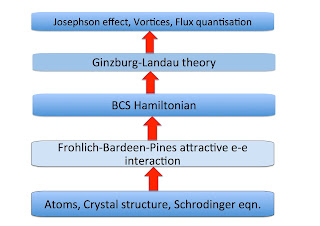Superconductivity is arguably the most intriguing example of emergent phenomena in condensed matter physics. The introduction to an endless stream of papers and grant applications mention this. But, so what? Why does this matter? Are we just invoking a "buzzword" or does looking at superconductivity in this way actually help our understanding?
When we talk about emergence I think there are three intertwined aspects to consider: phenomena, concepts, and effective Hamiltonians.
For example, for a superconductor, the emergent phenomena include zero electrical resistance, the Meissner effect, and the Josephson effect.
In a type-II superconductor in an external magnetic field, there are also vortices and quantisation of the magnetic flux through each vortex.
The main concept associated with the superconductivity is the spontaneously broken symmetry.
This is described by an order parameter.
The figure below shows the different hierarchies of scale associated with superconductivity in elemental metals. The bottom four describe effective Hamiltonians.
The hierarchy above was very helpful (even if not explicitly stated) in the development of the theory of superconductivity. The validity of the BCS Hamiltonian was supported by the fact that it could produce the Ginzburg-Landau theory (as shown by Gorkov) and that the attractive interaction in the BCS Hamiltonian (needed to produce Cooper pairing) could be produced from screening of the electron-phonon interaction by the electron-electron interaction, as shown by Frohlich and Bardeen and Pines.Have I missed something?





The emergence concept is one of the most beautiful in condensed matter systems. In the topological phases is even more exotic (and surprising, for me, at least), due the "global" order parameter associate with the topological index, in this sense, the emergence concept is even more powerfull and elegant.
ReplyDelete